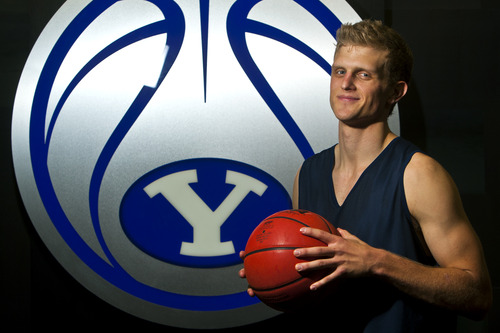This is an archived article that was published on sltrib.com in 2013, and information in the article may be outdated. It is provided only for personal research purposes and may not be reprinted.
New York • In a move that has turned out to be as serendipitous as anything it has done lately, BYU honored a couple of players who led the Cougars to the 1951 National Invitation Tournament championship by retiring their jerseys at the Marriott Center on Feb. 16 with many of their teammates in attendance.
Little did current players know back then, when they were listening in their locker room to Mel Hutchins and Roland Minson tell them how they did it — with togetherness — that they would get their chance some 62 years later.
But here the 24-11 Cougars are, preparing to meet 21-14 Baylor on Tuesday in an NIT semifinal game (5 p.m. MDT, ESPN2) at perhaps the most famous basketball venue in the country, Madison Square Garden. The winner takes on either Iowa or Maryland for the NIT crown.
"Growing up, you always have dreams of playing at a place like that," said star guard Tyler Haws.
The 1951 team was known as "The Homeless Cats" because the Smith Fieldhouse was under construction that year, so they used the University of Utah's Einar Nielsen Fieldhouse and Springville High School for their home games. Coached by Stan Watts, the team that counted Hutchins, Minson, Harold Christensen, Jerry Romney and Joe Richey among its best players will be forever known as BYU's first national championship team in any sport.
The NIT at the time was considered the decisive tournament for the country's best collegiate basketball team, but not as much as the NCAA Tournament is now.
The 2012-13 Cougars have strong connections with BYU's 1966 NIT championship team as well.
Jim Jimas, the former Bingham High standout who made a steal and a couple of quick baskets to help the Cougars down Army 97-60 in the semifinals and would later earn All-Western Athletic Conference honors, went on to coach at Hillcrest and Brighton high schools, and his best player at Hillcrest was Marty Haws, Tyler's father.
And Neil Roberts, another sub on the 1966 champions, went on to coach at Saint George's Dixie College, where he recruited a sweet-shooting guard by the name of Dave Rose — BYU's current coach. Rose said Saturday that he hasn't had as much success getting his players' attention regarding the program's history as Hutchins and Minson did.
"I have talked to the guys a lot through different seasons about the past and the history of BYU basketball, just to try to throw it out there," Rose said. "The players, they know a little bit about Danny Ainge [who led BYU to the NCAA Tournament's Elite Eight in 1981]. You get past that, it gets pretty tough."
Also coached by Watts, the 1966 team is much like the current one because it featured a roster full of native Utahns.
The stars were Jeff Congdon, Jim Eakins, Dick Nemelka, Bill Ruffner, Craig Raymond, Steve Kramer, Randy Schouten and the recently deceased Gary Hill, of Gunnison, still the leading scorer in Utah schoolboy basketball history.
Similarly, no fewer than eight members of the current team grew up within 30 miles of BYU's campus.
Were the 1966 champions a big deal back then?
Here's how Sports Illustrated's Mervin Hyman described the 97-84 victory over local favorite New York University (NYU) on March 28, 1966: "A bit of unrehearsed pandemonium broke out in New York's Madison Square Garden. Six pretty flag twirlers, after enchanting appreciative New Yorkers with their dance routines, rushed out to embrace five sweaty Brigham Young basketball players who in turned raised beaming coach Stan Watts to their shoulders and jounced him up and down, his bald head gleaming in the bright Garden lights.
"The BYU band, 25 strong and present only because schoolmates back in Provo, Utah, had managed to wheedle $5,000 out of alumni and friends to pay its way, happily tootled, "Rise and shout, the Cougars are out.' "
Hyman continued, "In three games, the Cougars played before more people than the entire population of Provo ... for a team that had to scramble and claw for its victories, it was a richly satisfying accomplishment. They had finished second to Utah in the Western AC, despite twice beating the Redskins — who reached the NCAA semifinals — and had a 17-5 record."
drew@sltrib.comTwitter: @drewjay —
NIT Final Four
BYU's previous appearances:
1951
Semifinals
BYU 69, Seton Hall 59
Finals
BYU 62, Dayton 43
1966
Semifinals
BYU 97, Army 60
Finals
BYU 97, NYU 84 —
2013 NIT Semifinals
P At Madison Square Garden, New York
Tuesday's games
• BYU vs. Baylor, 5 p.m. MDT, ESPN2
• Maryland vs. Iowa, 7 p.m., ESPN2



